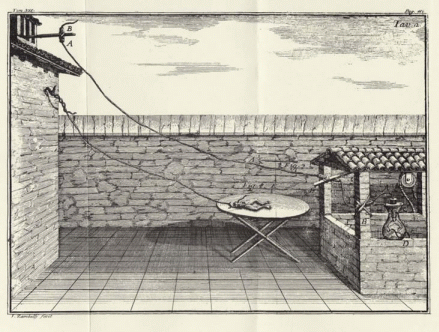Luigi Galvani (continued)
Let's read the description that Galvani gave of one of his experiments:
"The experiment was successful, according to our expectations, exactly as in the case of artificial electricity: each time a lightning was seen, in that very instant all muscles underwent violent and numerous contractions, in such a way that, just as flashes of lightning are used to anticipate thunder and, as one may say, almost pre-announce it, in the same way the movements and muscular contractions of those animals; more than that, the manifestation of the phenomena was so impressive that the contractions took place even if the conductor was not applied to the muscles and the conductors of the nerves were not isolated; furthermore, beyond any hope and expectation, the same facts were observed with the the conductor being placed even at lower positions, mostly if the flashes of lightning were powerful and came from clouds near to the site of the experiments, or if someone held the cable (F) in his hands at the moment when the flashes were emitted."
|
|
| Fig. 4:
Illustration of the experiment in which Galvani
showed that the nerve of the frog was excited by an electric atmospheric
discharge detected by his receiver. In this case it is the (isolated)
wire hanging from A that works as an antenna. The frog contained in the
vessel D is connected to it. To its extremity is connected another
conductor that ends in the water of a well. (Credit: Dall'opera "De viribus electricitatis in motu musculari commentarius") |
In this case the experimental apparatus corresponds even more closely to a receiving radio-telegraphic device, while the emitting role is played by nature. The character of transmission at a distance is much more evident. The Galvanian antenna derives from the metallic wires used by Benjamin Franklin in order "to capture atmospheric electricity" and from the lightning rod.
Later on Galvani discovered that the muscular contractions took place also when, once the frog was lying on an iron plate, a brass hook was pushed against it. Contractions appeared to depend on the metal used. In a series of experiments, in which the same effects were manifested, Galvani used metallic arcs, one of whose extremities was put in contact with the brass hook, which in turn was put in contact with the spinal marrow, the other with the muscles of a leg. How should this result be interpreted?
Galvani made the hypothesis of an "electricity intrinsic in the animal", which, put in circle by the external bimetallic arc, produced the contraction of the muscles. For him, the frog's muscle, besides being an extremely sensitive detector, was thus also a "container" of electricity.
All these results were expounded by Galvani in his work De viribus electricitatis in motu musculari commentarius, published in 1791.
This is a wonderful piece of work, of great scientific value and also easy to understand.
|
|
